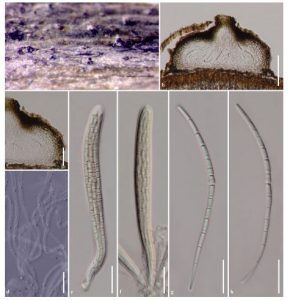Pseudoophiobolus achilleae Phookamsak, Wanas., E. Camporesi & K.D. Hyde, sp. nov. Index Fungorum number: IF553923
Etymology: The specifific epithet ‘‘achilleae’’ refers to the host Achillea.
Holotype: MFLU 17-0933
Saprobic on Achillea millefolium L. Sexual morph: Ascomata 120–200 lm high (excluding papilla), 220– 330 µm diam., dark brown to black, scattered, gregarious, semi-immersed to erumpent through the host epidermis, subglobose to hemisphaerical, uni-loculate, glabrous, ostiolate, papillate. Papilla 80–120 µm high, 60–95 µm diam., minutely mammiform, with rounded to truncate apex, composed of several layers of thick, brown to dark brown, pseudoparenchymatous cells, arranged in a textura angularis to textura prismatica, ostiole central, with pore-like opening, with indistinct periphyses. Peridium 15–55 µm wide, thin- to thick-walled, of unequal thickness, thin at the base, thicker at the sides towards the apex, composed of several layers of hyaline to dark brown, pseudoparenchymatous cells, inner layers comprising 3–5 layers of hyaline, thick-walled cells, arranged in a textura angularis, outer layers comprising several layers of thickened, dark brown to black cells, arranged in textura angularis to textura prismatica. Hamathecium composed of dense, 1.8–3.7 µm wide, cellular pseudoparaphyses, distinctly septate, not constricted at the septa, anastomosing at the apex, embedded in a hyaline gelatinous matrix. Asci (105–)120–140(–150) 9 (11–)12–14 µm (x = 133 x 12.8 µm, n =30), 8-spored, bitunicate, fifissitunicate, cylindrical to cylindric-clavate, short pedicellate, with furcate pedicel, apically rounded, with well-developed ocular chamber. Ascospores 110–130(–132) x (2.5–)3–4 µm (x = 122.3 x 3.5 µm, n = 30), fasciculate, in parallel, scolecosporous, subhyaline to pale yellowish, subcylindric-clavate to fifiliform, with rounded ends, tapered towards the lower cells, swollen at the 7th–8th, or 9th–10th cell, 13–15(–18)(–23)-septate, usually constricted at the 7th septum at the base of the swollen cell, not constricted at the other septa, smooth walled. Asexual morph: Undetermined.
Material examined: ITALY, Province of Forlı`-Cesena [FC], Galeata, near Passo delle Forche, on dead stem of Achillea millefolium L. (Asteraceae), 15 April 2014, E. Camporesi, IT 1815 (MFLU 17-0925, holotype).
Notes: Pseudoophiobolus achilleae is introduced as a new species from Achillea millefolium in Italy. Many ophiobolus-like taxa have been reported from Achillea millefolium such as Ophiobolus anguillides, O. erythrosporus, O. mathieui and O. nigroclypeatus (Shoemaker 1976; Farr and Rossman 2017). Pseudoophiobolus achilleae differs from Ophiobolus anguillides in having subhyaline topale yellowish, 13–15(–18)(–23)-septate ascospores, swollen at the 7th–8th, or 9th–10th cell, whereas O. anguillides has yellowish, 14–17-septate ascospores, swollen at the apical cell, and are snake-like (Shoemaker 1976). Ophiobolus mathieui is different in having narrow, hyaline to pale yellowish, 11–13-septate ascospores, swollen at a middle part of the 4th cell (Saccardo 1883; Shoemaker 1976). Ophiobolus mathieui is synonymized under Pseudoophiobolus mathieui in this study. Ophiobolus nigroclypeatus differs from P. achilleae in having shorter, aseptate ascospores (Miller and Burton 1942). Pseudoophiobolus achilleae resembles P. subhyalinisporus in its shape and colour of ascospores. However, P.achilleae differs from P. subhyalinisporus based on its size, septation and swollen cells of ascospores (Table 3). Multigene phylogenetic analyses also support that P. achilleae is distinct from P. subhyalinisporus. A comparison of ITS sequence data shows that P. achilleae differs from P. subhyalinisporus in 16 base positions (data not shown).
Hosts: Achillea millefolium L.(Asteraceae)
Distribution: Italy
FIG Pseudoophiobolus achilleae (MFLU 17-0925, holotype). a Appearance of ascomata on the host surface. b Section through ascoma. c Section through peridium. d Pseudoparaphyses stained in Nigrosine. e, f Asci. g, h Ascospores. Scale bars: b = 100 µm, c = 50 µm, e–h = 20 mµ, d = 10 µm

